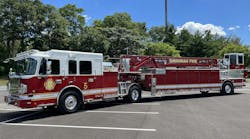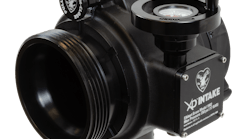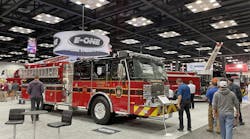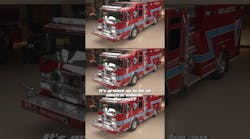Much like the title of the Bob Dylan album released in 1964, "The Times They Are a-Changin' " as the fire apparatus industry undergoes significant changes and upheaval. While there is no one factor to attribute the changes in the apparatus playing field, in this article we will attempt to discern the important factors for your fire department to consider when specifying apparatus in the future.
One factor that the apparatus industry must deal with goes beyond the bounds of the fire and emergency services and impacts just about every aspect of consumer goods and services. The economy in this country is going through a very rocky period with respect to inflation and the costs of many consumer products. The rate of inflation has advanced due to the cost of petroleum and crude oil products, together with the weakened value of the U.S. dollar in the global market. You only have to look at the cost of a gallon of gasoline or diesel fuel just 12 months ago, compared to what you are paying now. There are many countries in the Middle East and Far East where their national economies are booming, thereby strengthening the value of their currency against the dollar. As a result, the balance of trade favors these emerging nations and weakens our nation's economy, at least in the short term.
As most fire apparatus bodies are constructed of aluminum or steel, the apparatus industry is closely tied to the cost of these materials. During the first six months of 2008, the cost of these two materials increased between 28% and 42%. Combined with the increased costs of component parts such as pumps, gauges, generators and other hardware, this has dramatically increased the cost of producing a completed fire truck. In the past, the apparatus industry has been able to maintain annual cost increases that were in line with the general pace of inflation. One could analyze the government figures released covering the Producer Price Index to predict what financial resources would be needed for major acquisitions. Unfortunately, during 2008, the cost of new fire apparatus has outpaced inflation with actual costs increasing almost monthly with no apparent end in sight.
While there may be skeptics who believe otherwise, you only need to look at the apparatus industry's history over the past few years to reveal that there has been a fair amount of upheaval within the market. Whether due to changes in ownership or management or a lack of product definition, a number of manufacturers have dramatically changed their operating systems and product offerings in an attempt to remain competitive and viable in the marketplace. The overall numbers of fire apparatus purchased in North America has not changed significantly for the past several years. Combined with the impact of the 2007 Environmental Protection Agency (EPA)-compliant diesel engine design, this caused all of the custom-chassis builders to re-engineer their cabs to accommodate the new engines and required cooling systems. As the number of custom-chassis apparatus has also remained constant, the opportunity to capitalize on these designs is somewhat limited. Once again, in 2010, diesel engine emissions will change with the next round of EPA regulations with all of the custom chassis apparatus builders having to work on the packaging necessary to install these engines within the confines of their respective cabs. Consider as well that Caterpillar and Detroit Diesel engines are no longer going to be available to the emergency services market in custom fire chassis and you may get a sense of the overall future of fire apparatus in our country.
During a recent Firehouse.com podcast, one of our guests made an astute observation relating to the 2010 engine availability when he said, "We are one corporate decision away from the demise of the custom fire truck industry." Sad, but true. Fire apparatus design in North America - whether engine, truck or rescue squad - is unique to our geographic area. Consider the overall design of an engine company for FDNY as compared to engine apparatus in your area. The similarities are that each unit carries personnel, hose, water, a fire pump and equipment. Beyond that, there is probably little commonality between your department's standard engine and any one of the 204 engines in the FDNY fleet.
Fire apparatus in many nations outside the U.S. are standardized by the government with identical apparatus in most, if not all communities. This is not to suggest that we in the U.S. adopt this measure; however, we need to understand that as advanced as our firefighting technology and methods may be in our location, very little fire apparatus design that is utilized throughout our nation is employed anywhere else on the globe. The result is that fire apparatus built in the U.S. have little appeal to the rest of the worldwide fire service and that means that the annual demand for new fire apparatus within North America remains a non-growth market.
Beginning in January 2009, the new edition of the National Fire Protection Association (NFPA) 1901 Automotive Fire Apparatus Standard will take effect, incorporating many changes intended to enhance firefighter safety when operating new apparatus. The overall cost impact for new apparatus that include the requirements of this new standard will be between $8,000 and $12,000 per unit. When developing your budget request for new or replacement units, you must be sure to include these amounts when securing your finances. More importantly, you will need to carefully evaluate your timetable for bidding the apparatus and determining exactly when your department will be able to enter into a contract with the successful bidder.
In the past, the apparatus industry has been able to adjust pricing on an annual or semi-annual basis to account for material and labor cost increases. With the current impact of inflation, especially on material costs, this premise may no longer be valid. Apparatus committees should encourage the manufacturers that they are considering to develop, in advance, a time frame that will minimize the department's exposure to any anticipated price increases in the short term. As most departments operate within the constraints of a budget system, it is imperative that a realistic budget be initially established for the project to ensure that the department will not have to endure cost-cutting measures late in the project to bring the apparatus within the budget allocation.
The cost impact of the 2010 EPA diesel engines is largely unknown at this time. It will be somewhat easier for custom-chassis builders to redesign their cabs as Cummins diesels appear to be the predominant engine offering. However, with the increased cooling requirements and after-treatment devices that will be associated with the new engine design, there will be some dimensional changes and certainly added cost to the overall engineering design for each apparatus. If your department is considering the purchase of any new apparatus between 2008 and 2012, you should strongly consider advancing the purchase to acquire your apparatus as soon as possible. This will allow your department to minimize exposure to inflation as well as the cost avoidance for any future changes with the 2010 diesel engines. Departments should also be aware that the days of paying for a custom-built apparatus when the unit is completed may be going away. The apparatus industry will have to adopt payment plans that have been used in the building and construction industry for many years where progress payments are made through the contract and manufacturing process as a normal manner of conducting business.
Overall, the future of the fire apparatus industry is largely dependent on the economy of our country gaining a little stability with respect to the world market as well as getting some relief from the numerous government standards that regulate virtually every aspect of the manufacturing process. It can be said that the current fire apparatus engine debacle was caused in part by government regulation. Apparatus committees need to work closely with manufacturers to ensure that not only the proper specifications and components are detailed, but that all aspects of the unit financing and budget resources are in place throughout the life of the project.
TOM SHAND, a Firehouse® contributing editor, is a 33-year veteran of the fire service and works with Michael Wilbur at Emergency Vehicle Response, consulting on a variety of fire apparatus and fire department master-planning issues. He is employed by Seagrave Fire Apparatus LLC as a regional sales manager. MICHAEL WILBUR, a Firehouse® contributing editor, is a lieutenant in the New York City Fire Department, assigned to Ladder Company 27 in the Bronx, and has served on the FDNY Apparatus Purchasing Committee. He consults on a variety of apparatus-related issues around the country. For further information, access his website at www.emergencyvehicleresponse.com.





